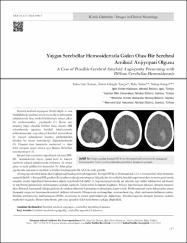| dc.contributor.author | Özmen, Selen Gür | |
| dc.contributor.author | Tunçer, Özlem Güngör | |
| dc.contributor.author | Tolun, Reha | |
| dc.contributor.author | Krespi, Yakup | |
| dc.date.accessioned | 2016-07-22T08:36:04Z | |
| dc.date.available | 2016-07-22T08:36:04Z | |
| dc.date.issued | 2013 | |
| dc.identifier.citation | Ozmen SG, Tuncer OG, Tolun R, Krespi Y. [A Case of possible cerebral amyloid angiopathy presenting with diffuse cerebellar hemosiderosis]. Turk J Neurol. 2013; 19(3): 117-118. doi: 10.4274/Tnd.99815 | en_US |
| dc.identifier.issn | 1301-062X | |
| dc.identifier.uri | http://tjn.org.tr/ | en_US |
| dc.identifier.uri | https://hdl.handle.net/11446/1040 | en_US |
| dc.description | İstanbul Bilim Üniversitesi, Tıp Fakültesi. | en_US |
| dc.description.abstract | Serebral amiloid anjiyopati (SAA) kortikal, subkortikal ve leptomeningeal arterlerde beta-amyloid proteinin birikimiyle oluşur ve lober intraserebral kanamanın nedenlerinden birisidir. Patoloji çalışmalarında bu birikim serebellumda da saptanmaktadır ve serebellar kanamaların SAA tanısını dışlatmadığı bilinmektedir. SAA’da günümüzde kesin tanı otopsiye dayandırılmakla birlikte kana duyarlı MR sekanslarında subaraknoid veya yüzeyel kortikal hemosideroz görüntüsünün klinikte bu tanıyı desteklediği düşünülmektedir. Sunulacak olguda saptanan yoğun serebellar hemosideroz santral sinir sistemi superfisyal siderozunda tipik bir bulgu olmakla birlikte SAA bu durumun nadir bir nedeni olduğundan istisnai bir durum oluşturmaktadır. | en_US |
| dc.description.abstract | Cerebral amyloid angiopathy (CAA) is caused by deposition of beta-amyloid protein on the walls of cortical, subcortical and leptomeningeal arteries and it is one of the causes of lobar intracerebral hemorrhage. The beta-amyloid protein deposits can be found in the cerebellum as well as the cerebrum. Cerebellar hematomas do not exclude the diagnosis of CAA. Definitive diagnosis of CAA is established by pathological examination at autopsy, however its diagnosis may be suggested by subarachnoid or superficial cortical hemosiderosis in blood sensitive MRI sequences. This case with an intense cerebellar hemosiderosis typical for superficial siderosis (SS) of the central nervous system is reported as a rare example of CAA as the underlying cause. | en_US |
| dc.language.iso | tur | en_US |
| dc.publisher | Türk Nöroloji Derneği | en_US |
| dc.identifier.doi | 10.4274/Tnd.99815 | en_US |
| dc.rights | info:eu-repo/semantics/openAccess | en_US |
| dc.subject | serebral amiloid anjiyopati | en_US |
| dc.subject | serebellar süperfisiyel sideroz | en_US |
| dc.subject | cerebral amyloid angiopathy | en_US |
| dc.subject | cerebellar superficial siderosis | en_US |
| dc.title | Yaygın serebellar hemosiderozla giden olası bir serebral amiloid anjiyopati olgusu | en_US |
| dc.title.alternative | A case of possible cerebral amyloid angiopathy presenting with diffuse cerebellar hemosiderosis | en_US |
| dc.type | article | en_US |
| dc.relation.journal | Türk Nöroloji Dergisi | en_US |
| dc.department | DBÜ, Tıp Fakültesi | en_US |
| dc.identifier.issue | 3 | |
| dc.identifier.volume | 19 | |
| dc.identifier.startpage | 117 | |
| dc.identifier.endpage | 118 | |
| dc.contributor.authorID | TR141067 | en_US |
| dc.contributor.authorID | TR118242 | en_US |
| dc.contributor.authorID | TR140963 | en_US |
| dc.relation.publicationcategory | Belirsiz | en_US |


















